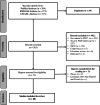Patient follow-up after discharge from the paediatric intensive care unit: A scoping review
- PMID: 39421878
- PMCID: PMC12090335
- DOI: 10.1111/nicc.13187
Patient follow-up after discharge from the paediatric intensive care unit: A scoping review
Abstract
Background: Most children admitted to a paediatric intensive care unit (PICU) now survive because of improvements in care. Many studies have identified the psychological, functional, cognitive and social impact of PICU admission on a child and their family. However, expert recommendations on follow-up are lacking.
Aim: To identify the strategies of clinical follow-up after PICU discharge performed from 2001 to 2021.
Study design: This scoping review was undertaken between January and April 2021 using three databases: PubMed, EMBASE and CINAHL. The search strategy consisted of a combination of keywords, including PICU, post-PICU discharge and follow-up in articles published between 2001 and 2021. The results are reported according to PRISMA-ScR guidelines.
Results: Six-hundred and fifty-two articles were identified and 68 were analysed. Median age was 4.5 years and the two main reasons for PICU admission were cardiorespiratory failure and sepsis. Median length of PICU stay was 8 days. Most follow-up was carried out by research units (88%), while 6% of studies reported follow-up by a multidisciplinary PICU team. The most common follow-up schedule included an assessment at PICU discharge, and then at 3, 6 and 12 months. Follow-up for >1 year was reported in 20% of studies. One third of studies focused on follow-up quality of life and neurological outcomes. Parental emotional impact was assessed in 7% of studies.
Conclusion: Follow-up after PICU discharge was highly heterogeneous regarding timing, health care professionals involved and assessment methods. There is an urgent need for standardization and coordination of PICU follow-up because of the increasing number of patients impacted by a PICU stay.
Relevance to clinical practice: Although most patients admitted to a paediatric intensive care unit (PICU) now survive; they may develop paediatric post-intensive care syndrome (PICS-P). To our knowledge, there are currently no clinical guidelines regarding follow-up after PICU discharge. This review summarizes current approaches to follow-up after PICU discharge, including how it is carried out, who is involved and what the main aims of assessment are.
Keywords: ICU outreach/follow‐up; paediatric intensive care; post‐intensive care syndrome; psychological issues and support.
© 2024 The Author(s). Nursing in Critical Care published by John Wiley & Sons Ltd on behalf of British Association of Critical Care Nurses.
Conflict of interest statement
The authors have no conflicts of interest relevant to the article to disclose.
Figures


References
-
- Rahmatinejad Z, Rahmatinejad F, Sezavar M, Tohidinezhad F, Abu‐Hanna A, Eslami S. Internal validation and evaluation of the predictive performance of models based on the PRISM‐3 (pediatric risk of mortality) and PIM‐3 (pediatric index of mortality) scoring systems for predicting mortality in pediatric intensive care units (PICUs). BMC Pediatr. 2022;22(1):199. doi:10.1186/s12887-022-03228y - DOI - PMC - PubMed
Publication types
MeSH terms
LinkOut - more resources
Full Text Sources
Miscellaneous

